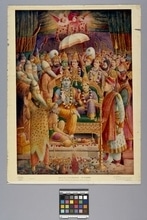Item number Eg265 from the MOA: University of British Columbia.
 Public
Public
Item Records
This page shows all the information we have about this item. Both the institution that physically holds this item, and RRN members have contributed the knowledge on this page. You’re looking at the item record provided by the holding institution. If you scroll further down the page, you’ll see the information from RRN members, and can share your own knowledge too.
The RRN processes the information it receives from each institution to make it more readable and easier to search. If you’re doing in-depth research on this item, be sure to take a look at the Data Source tab to see the information exactly as it was provided by the institution.
These records are easy to share because each has a unique web address. You can copy and paste the location from your browser’s address bar into an email, word document, or chat message to share this item with others.
- Data
- Data Source
This information was automatically generated from data provided by MOA: University of British Columbia. It has been standardized to aid in finding and grouping information within the RRN. Accuracy and meaning should be verified from the Data Source tab.
Description
Rectangular print of a blue-skinned male, Rama, carrying a bow and quiver, seated with female, Sati, who wearing a purple sari. Both are seated on a green-cushioned, green and red jewel-encrusted gold throne. Kneeling at their feet is Hanuman. Another male behind throne shades the couple with white umbrella, while two others in gold crowns stand with him, one with a green face. White-haired and bearded males stand at side on left in crowd of males and females clustered behind throne. In foreground, two males stand flanking couple. All colours muted and have pink tone. Print entitled 'Sri Rama Pattabhishek'.
History Of Use
Indian popular religious prints have been published for nearly a century, first by German presses, later by Indian ones. The prints may take the form of calendars, posters, or simply images. The style of the representations is European. In the beginning they were Hindu images, but are now acquiring elements both of folk art and a romantic secularism. It is a living art currently influenced by the movie industry and non-Hindu religions. The images are a vehicle for advertising and are also used for religious purposes. This print was produced, framed, and displayed in a prayer room for 'puja' or worship.
Narrative
Rama, the most perfect of princes, and his noble wife Sita portray the ideal couple by their acts of self-denial for the good of society. Popular episode is Rama's rescue of Sita from the ten-headed demon king, Ravana, with the help of Hanuman and Lakshmana.
Iconographic Meaning
Rama, seventh incarnation of Vishnu, is identified by the presence of his ideal, loving wife, Sita, by his side; Vaishnavite 'u' on forehead; bow and arrow-filled quiver symbolizing masculine virtures; green-coloured skin; either dressed as a king or forest dweller; presence of Hanuman, half-human, half-monkey deity, often shown kneeling at Rama's feet; and presence of Rama's brother Lakshmana, also carrying an arrow-filled quiver.
Cultural Context
popular religious art
Item History
- Made by P. S. R. Rao (Maker) in India during 1933
- Collected between 1974 and 1982
- Owned by Stephen Inglis before January 1983
- Received from Stephen Inglis (Donor) during January 1983
What
- Name
- Identification Number
- Eg265
- Type of Item
- Overall
- height 50.8 cm, width 37.8 cm
Where
- Holding Institution
- MOA: University of British Columbia
- Made in
- India
Who
- Culture
- South India
- Creator
- P. S. R. Rao (Maker)
- Previous Owner
- Stephen Inglis
- Received from
- Stephen Inglis (Donor)
When
- Creation Date
- during 1933
- Collection Date
- between 1974 and 1982
- Ownership Date
- before January 1983
- Acquisition Date
- during January 1983
Other
- Item Classes
- works on paper
- Condition
- fair
- Accession Number
- 0857/0120
Ask a question
Let the RRN community answer your questions
 Public
Public
With an account, you can ask other users a question about this item. Request an Account
Shared Knowledge
Share your knowlege of this item with the RRN community
 Public
Public
With an account, you can submit information about this item and have it visible to all users and institutions on the RRN. Request an Account









